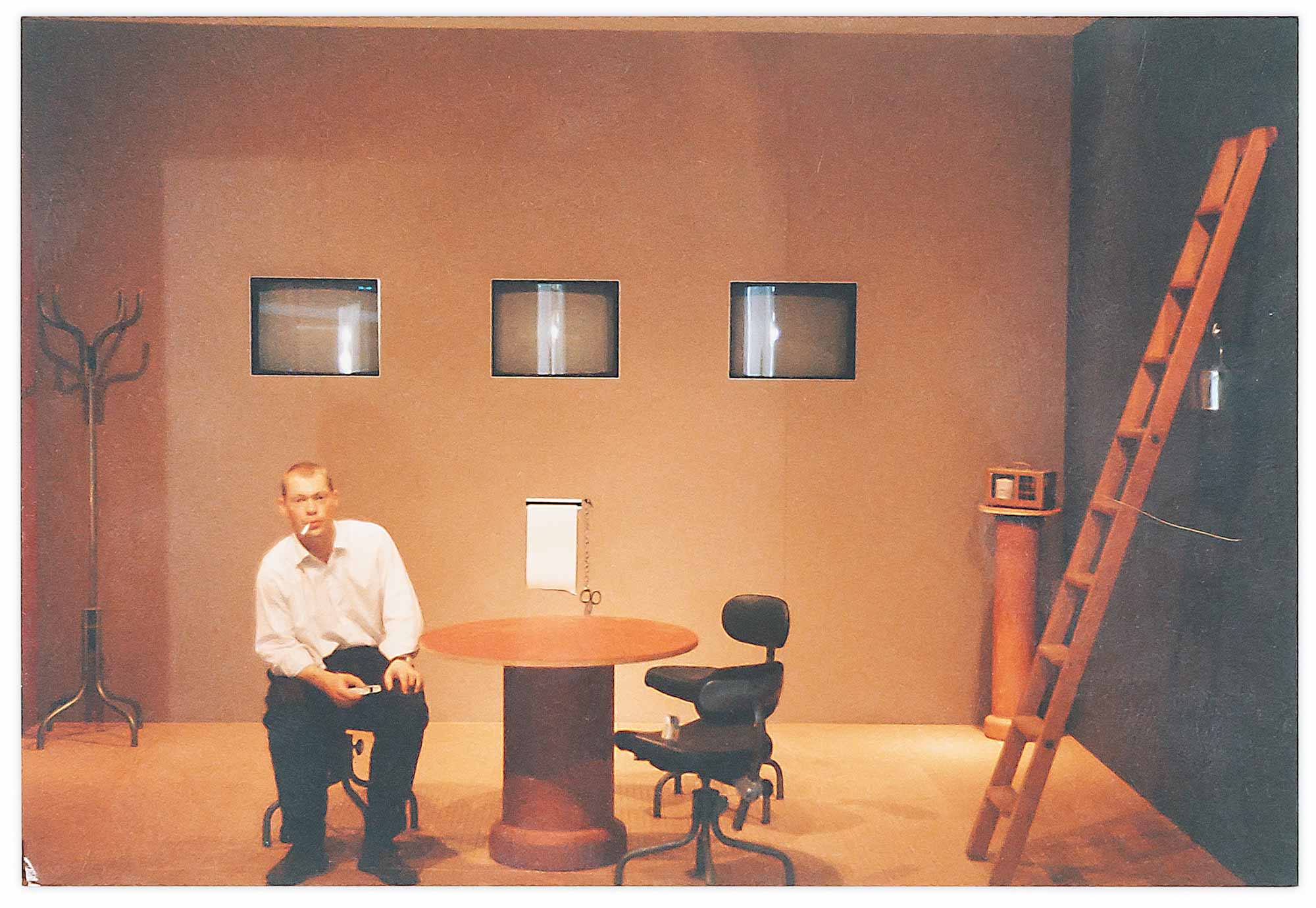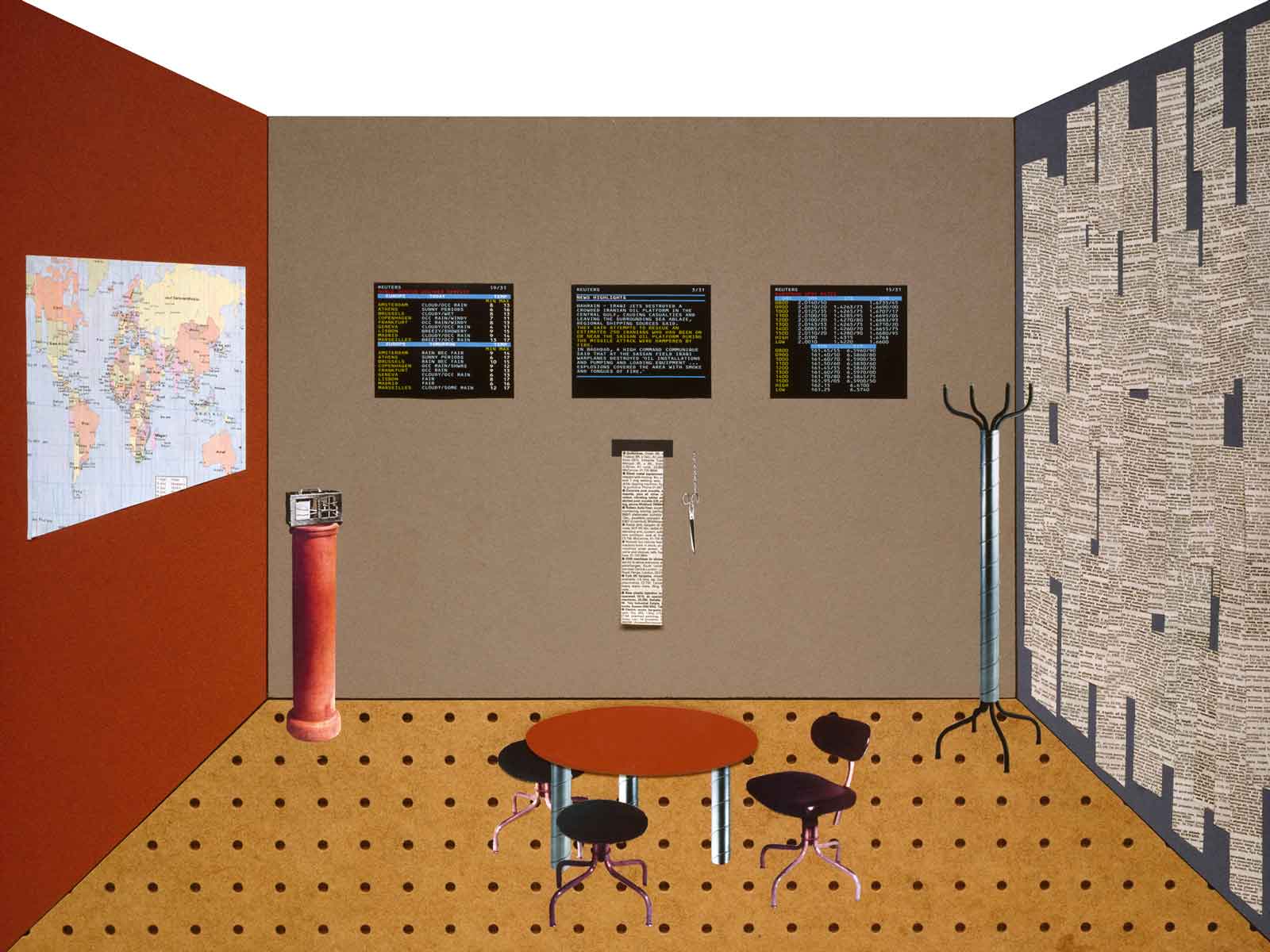In 1986 Michael Erlhoff asked Jasper to take part in Documenta 8, the international contemporary art exhibition that takes place in Kassel, Germany, every five years. Michael had been asked to be one of the curators and introduce some designers into the exhibition. The pair already knew each other: Michael had included Jasper in Design als Gegenstand, and he had bought the prototype of the Laboratory Light.
In October Jasper received the official letter of invitation to participate in Documenta from the artistic director Manfred Schneckenburger and Michael Erlhoff.
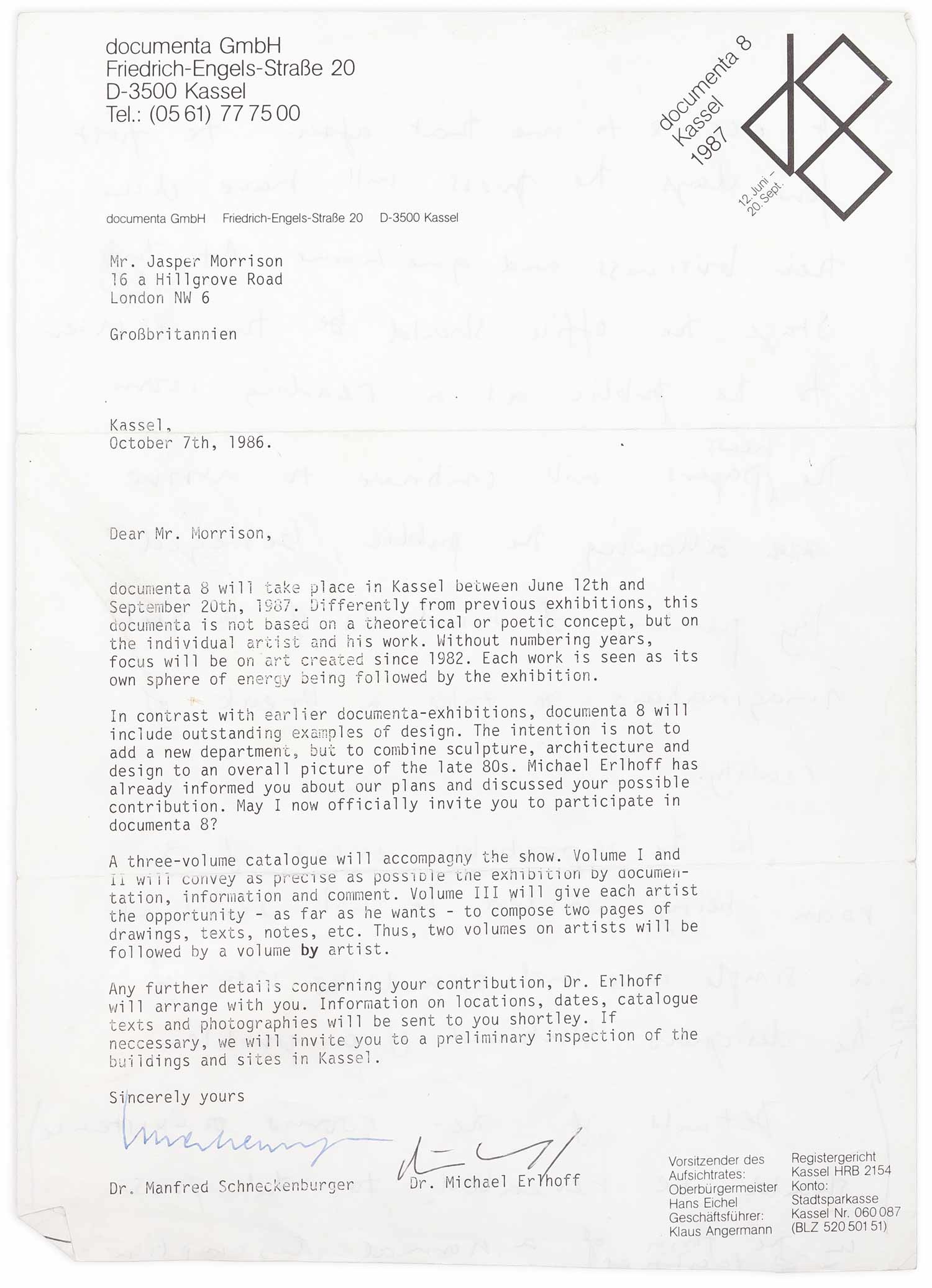
The letter of invitation from Documenta 8.
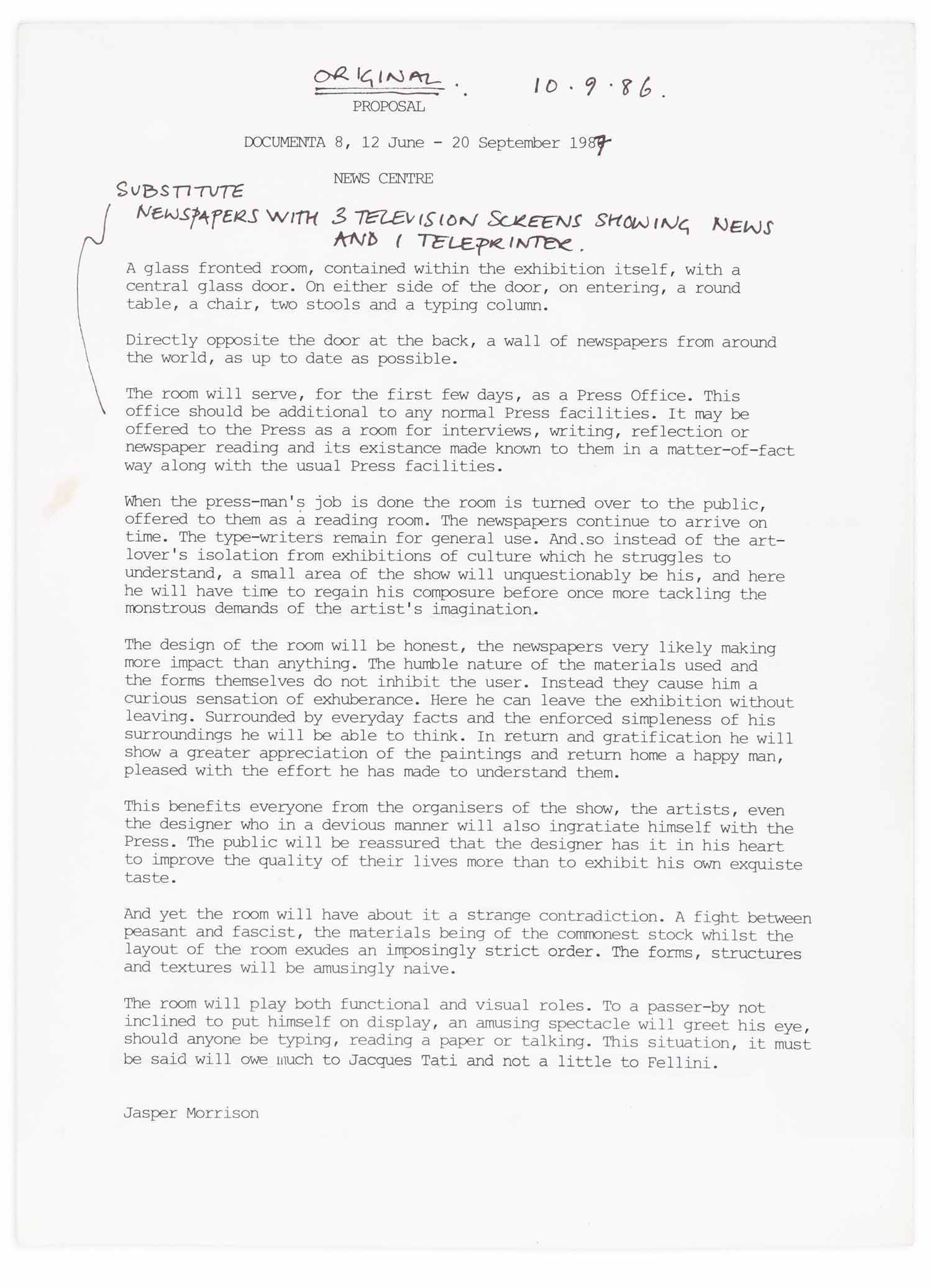
Jasper’s initial proposal for a News Centre.
Jasper then wrote a proposal for his project: A glass fronted room, contained within the exhibition itself, with a central glass door. On either side of the door, on entering, a round table, a chair, two stools and a typing column.
Directly opposite the door at the back, a wall of newspapers from around the world, as up to date as possible.
He wished his room to be within the exhibition itself – rather than in the design section – where it would serve as a press office for the exhibition before becoming a reading room for the visitors.
The room will serve, for the first few days, as a Press Office. This office should be additional to any normal Press facilities. It may be offered to the Press as a room for interviews, writing, reflection or newspaper reading and its existence made known to them in a matter-of-fact way along with the usual Press facilities.
When the press-man’s job is done the room is turned over to the public, offered to them as a reading room. The newspapers continue to arrive on time. The type-writers remain for general use. And so instead of the art-lover’s isolation from exhibitions of culture which he struggles to understand, a small area of the show will unquestionably be his, and here he will have time to regain his composure before once more tackling the monstrous demands of the artist’s imagination.
The design of the room will be honest, the newspapers very likely making more impact than anything. The humble nature of the materials used and the forms themselves do not inhibit the user. Instead they cause him a curious sensation of exuberance. Here he can leave the exhibition without leaving. Surrounded by everyday facts and the enforced simpleness of his surroundings he will be able to think. In return and gratification he will show a greater appreciation of the paintings and return home a happy man, pleased with the effort he has made to understand them.
Jasper intended that different companies sponsor the objects in the room according to their interest. He hoped that the News Centre would achieve some of the absurdity of films by Jacques Tati and Federico Fellini.
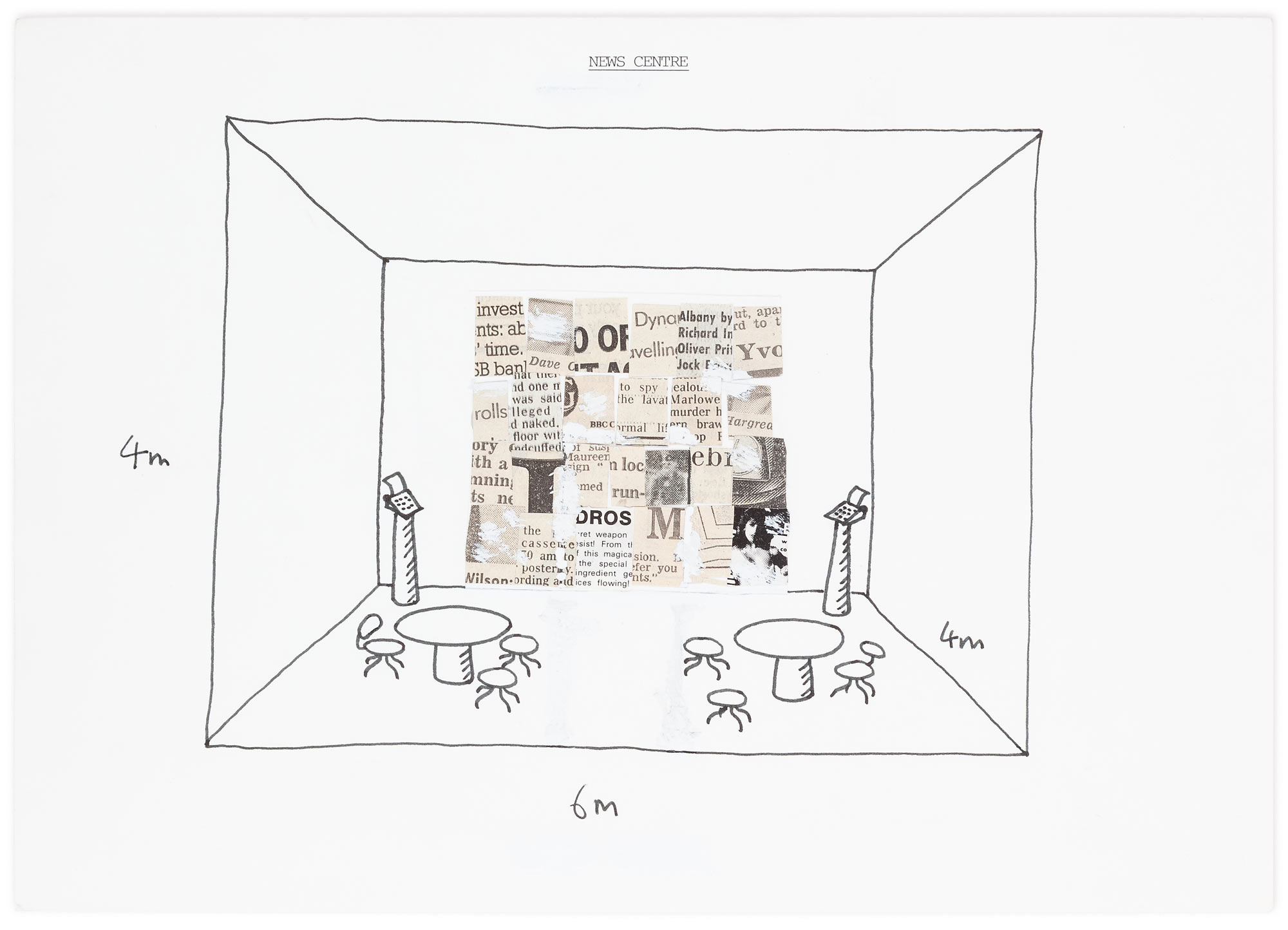
Jasper’s first sketch for his News Centre, with collaged newspapers.
Asked to take part in Documenta 8 as a designer, I thought it my duty to offer some practical service, which I hoped would ‘provide respite from the demanding nature of the artist’s imagination’. I tried to think of a way to create a room which would be a relief from looking at endless pictures and artistic endeavour. Big shows are almost impossible because you see so many things, so my intention was to remind the public, on their way round, of reality. A News Centre, issuing nothing but facts, I estimated, would do the trick.
While I’d been living in Germany I had bought a rather fancy Sony World Receiver radio and used to listen to the BBC World Service. I got caught up with the idea of the Designer receiving world news in his studio cut-off from, but informed about, what was going on outside. It was also somehow wrapped up in the idea of an imaginary room which I had to design furniture for. Whatever I designed had to be treated for atmospheric effect in that room before I’d decide if it was good enough to go on with. So when Michael Erlhoff invited me to take part in the Documenta exhibition and offered me the space I started working on a room which would receive as much news as possible.
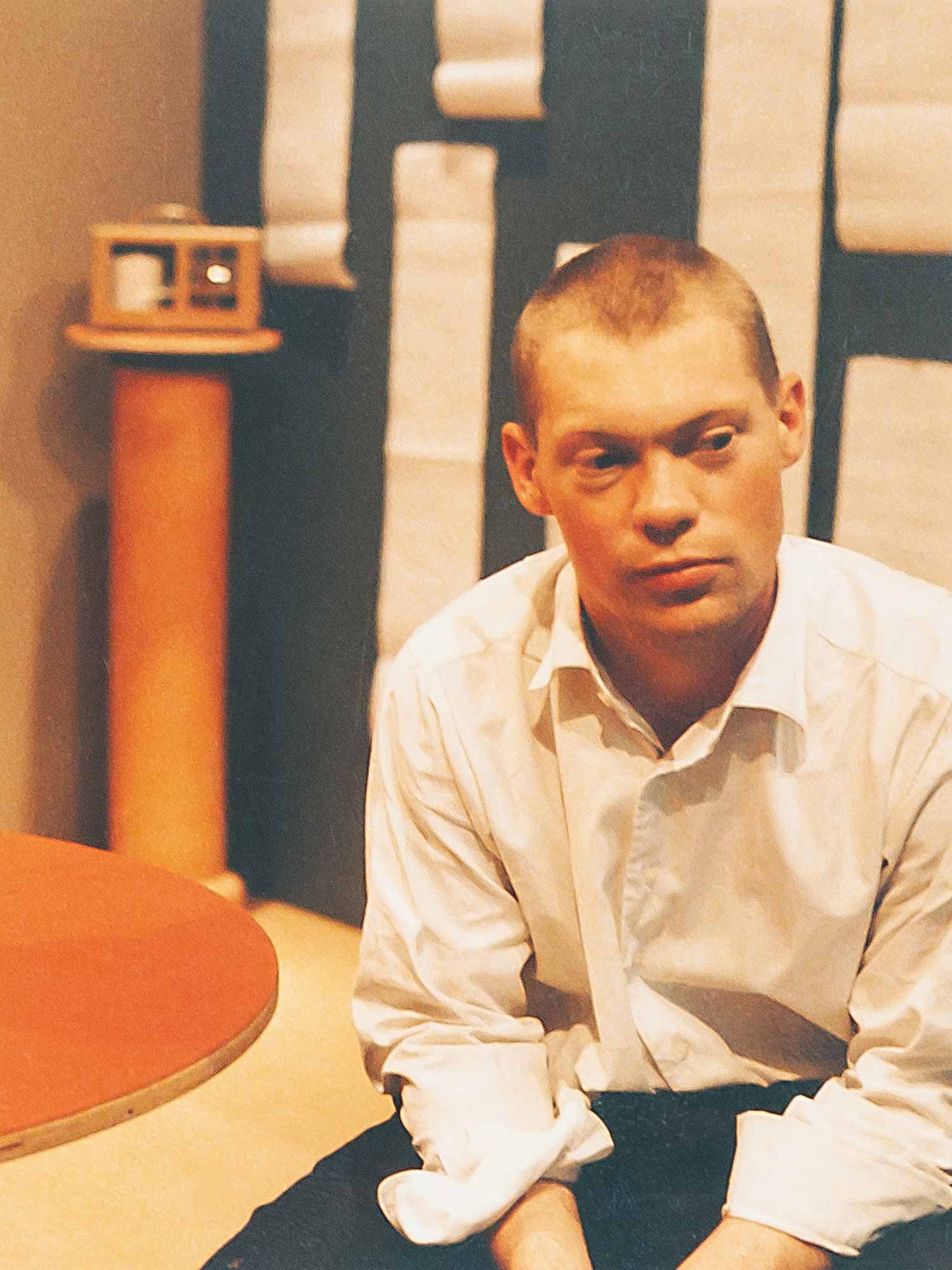
In response to his proposal, Michael Erlhoff confirmed that Jasper would be provided with a room of 6 x 4 metres but it could not be an actual press centre and it was not possible for his room to have glass doors.
In November Jasper approached the Reuters news agency asking them to sponsor his News Centre and sending them his proposal.
My dad managed the Reuters advertising account at JWT and introduced me to Mike Nelson who I wrote to to explain the idea. He asked me to come and see him and must have thought I was nuts. Apart from the family connection what might have swung it were the visitor numbers expected at Documenta and exposure to a bunch of wealthy culture lovers.
Mike Nelson put Jasper in touch with John Alcantara in the projects department at Reuters, who Jasper met in February 1987. There followed meetings, phone calls and correspondence before Reuters agreed in March to sponsor the room. Jasper’s discussions with Reuters brought significant possibilities and modifications to his scheme. The company could provide the latest news, both in teletext and the old tickertape systems. It had recently developed ‘News Watch’, a teletext service, due to be launched in April. Jasper now incorporated this product into his News Centre with the introduction of three Sony Trinitron monitors. He designed some graphics to be shown on the screens. He also added a teleprinter, the latest in ticker tape technology, to print off financial information.
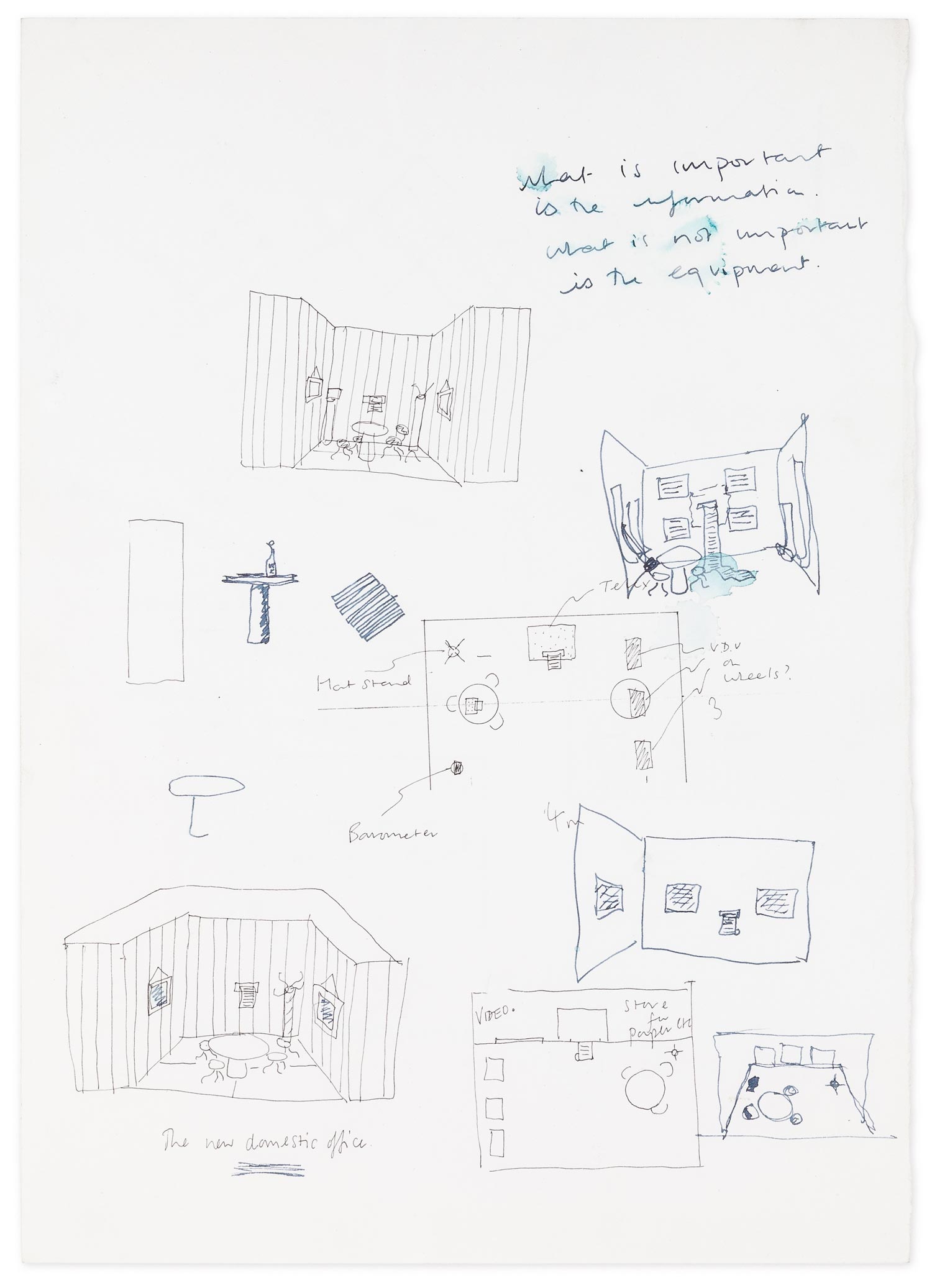


The revised sketch of the room incorporated screens.
In mid March Jasper updated Michael: Reuters are supplying me with a computerised news source in the form of three TV monitors linked to their central computer and a telex news printer which will be supplying the wall paper for the room. At the end of March he created the collage drawing of the room – pictured at the top of the page – for publication in the Documenta 8 catalogue.
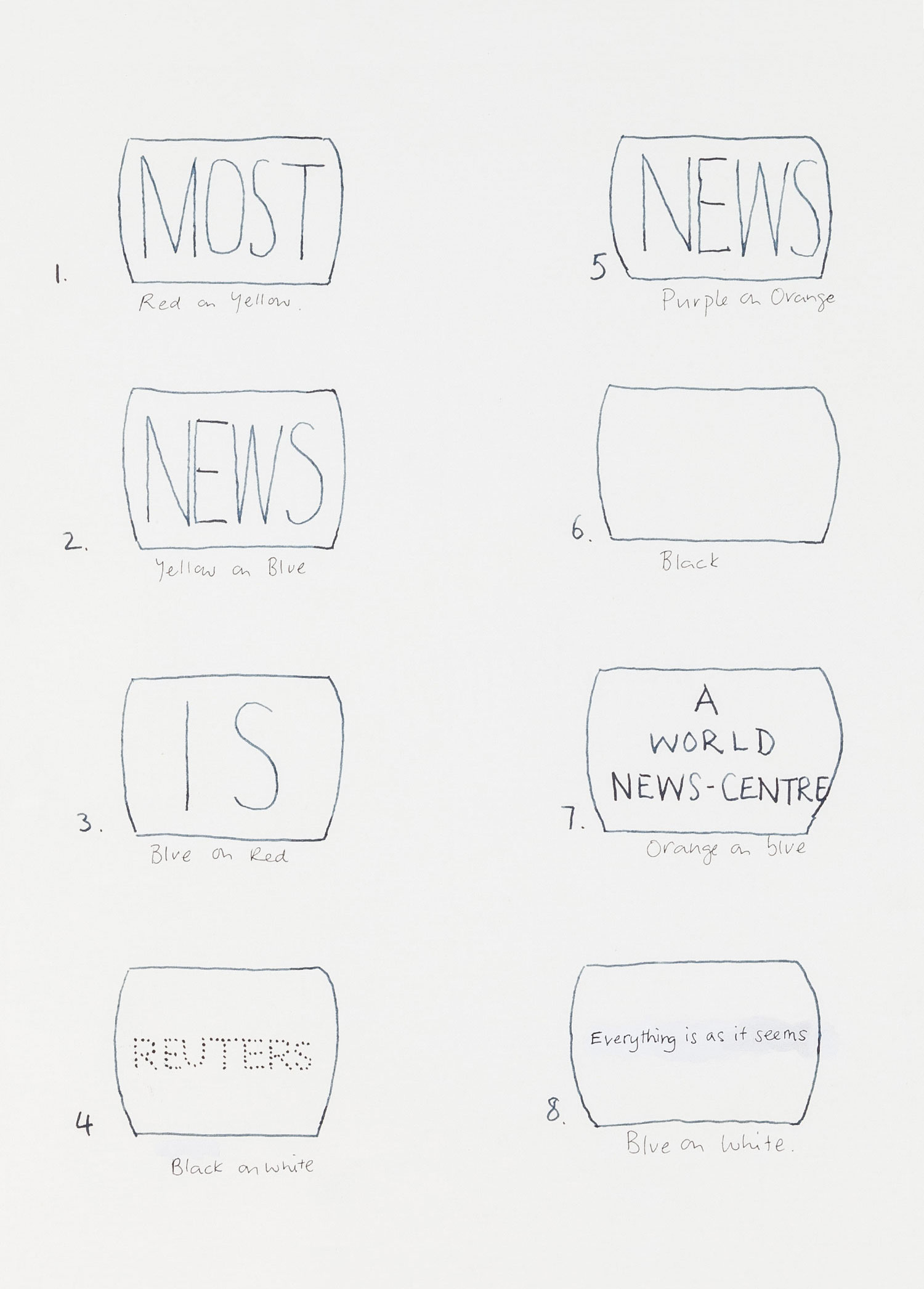
Designs for screen graphics.
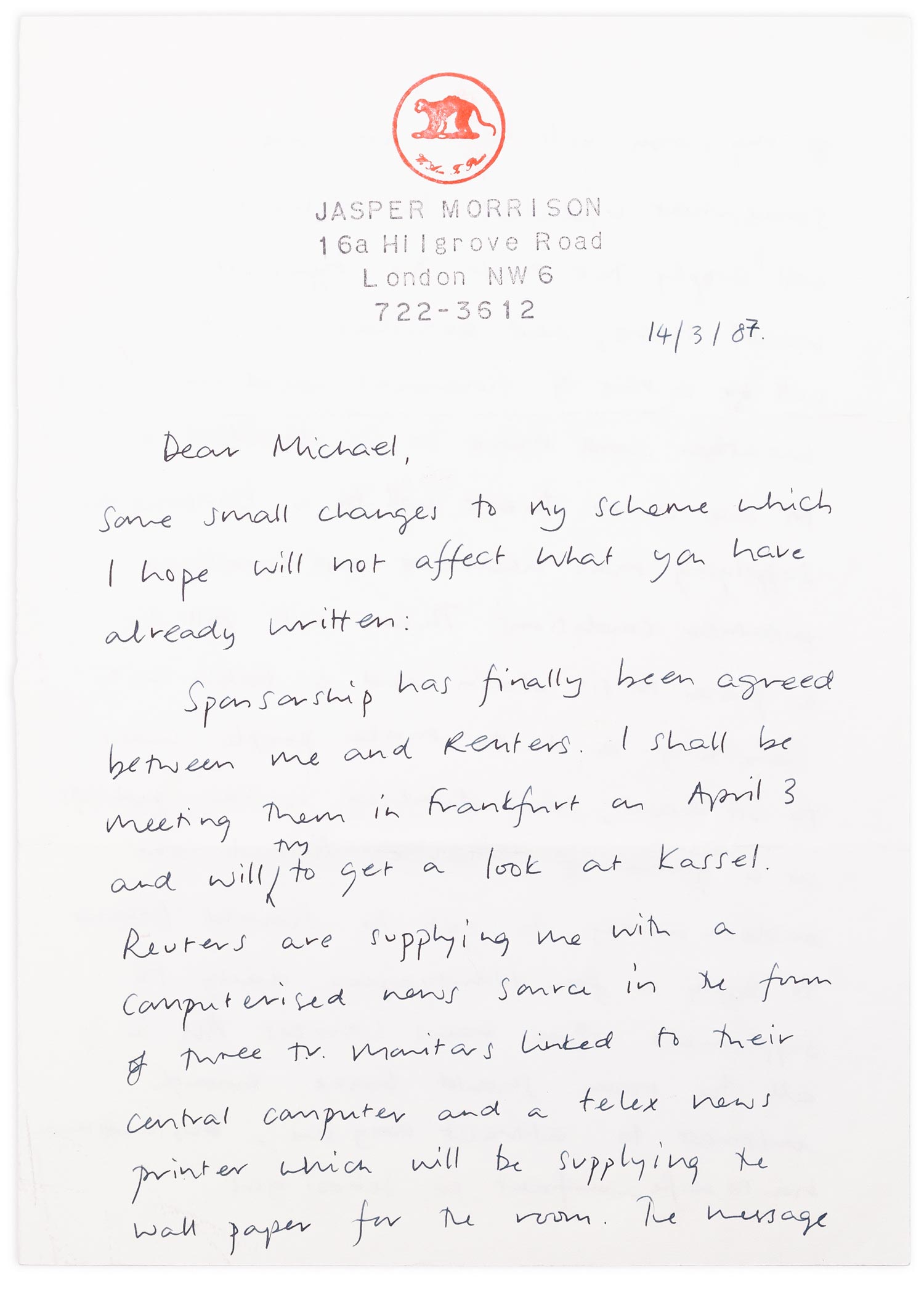
Jasper updated Michael following his discussions with Reuters.
Jasper liaised with Peter Sharrock at Reuters in Germany to supply and set up the equipment in the room, meeting him in Frankfurt in April. The project cost Reuters £20,000. Jasper intended that the visitors participate in the room by cutting off bits from the stream of paper from the printer and pinning it to the wall. In April he sent a ‘description’ and a ‘theory’ text for the Document 8 catalogue. The theory text was used in the publication, in German translation. It ran as follows:
The over-riding concept behind the News Centre is the contrast between the high technology News Watch product and the distinctly primitive assortment of other information sources and services. The variety of these sources, however, will add muscle to the News Centre’s complete information service as well as humour. The public’s fearless attitude towards TV screens, combined with the playful charm of the room will encourage their participation.
The scissors are there for anyone to use, as would the ladder and drawing pins, challenging the public to tidy the room or allow it to overgrow with print out. Given the public’s unwillingness to involve themselves in performance, the latter is more likely, kept in check by Documenta staff. As the Documenta progresses the wall of news will thicken with news reports. The radio desk, combined with the occasional noise from the teleprinter will provide yet another dimension to the volume of information the Centre will provide. The hat stand is there to evoke a feeling of old-world journalism whilst the barometer and map do their best to represent a weather centre. The materials used in construction are particularly humble and further the contrast of high and low technologies.
The room is pitched to amuse and fascinate the public, intrigue prospective News Watch subscribers and to fulfil my obligations as a participant, providing a contemporary and powerful design for a useful addition to this year’s Documenta.
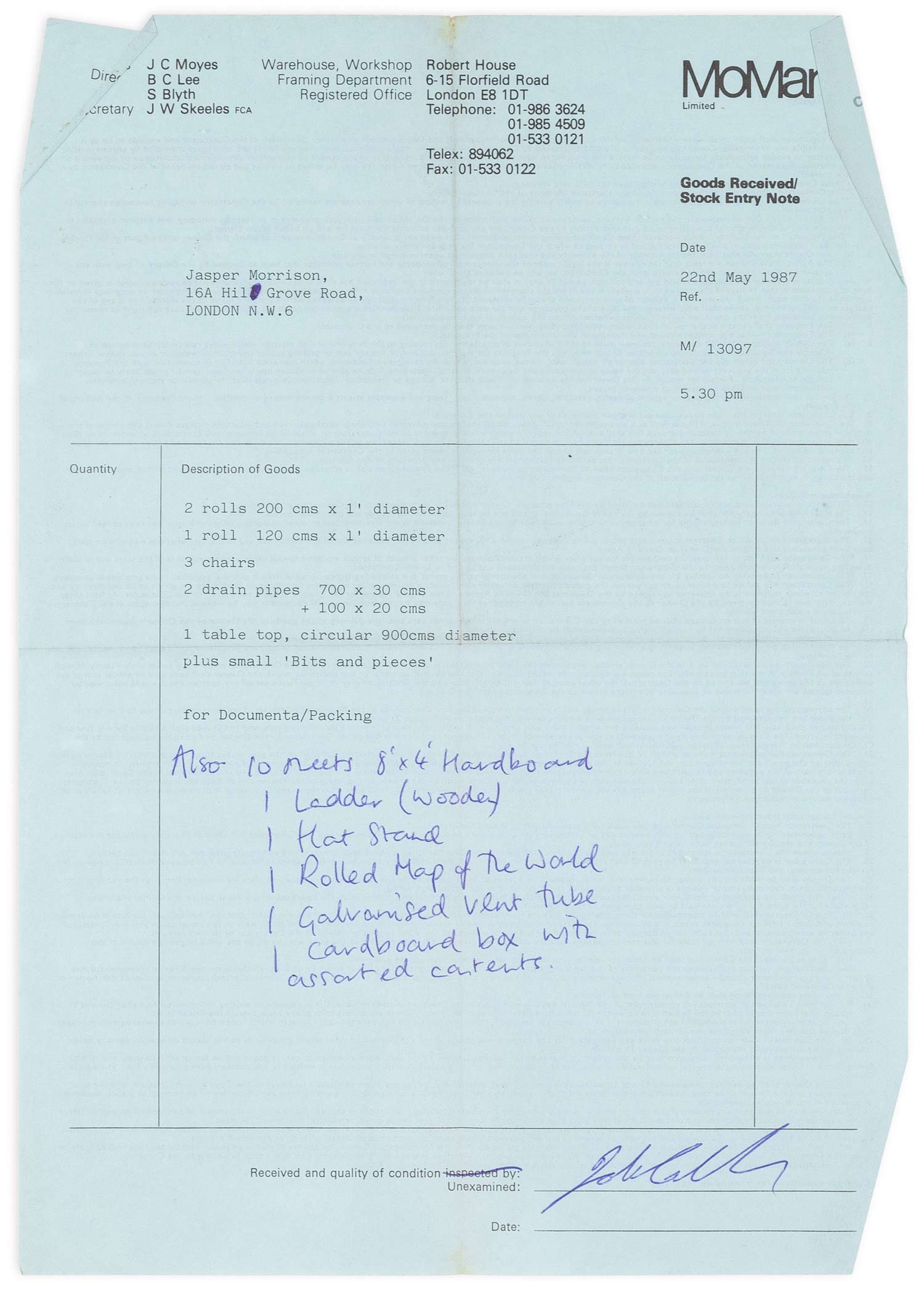
The despatch of items for the exhibition.
In May Jasper went about collecting the various props for the room, including selecting a map, a ladder, and cork for the floor. Later in the month he sent them off to Germany.
He had hoped the News Centre would be located within the exhibition rather than with the design exhibits. He preferred it to be seen ‘not so much as a design as a service’. However, just as he was preparing to despatch the contents of the room, Documenta’s artistic director Manfred Schneckenburger sent him a telegram to say that there was no space of the dimensions required for the News Centre in the main exhibition hall. As a result, the News Centre was located in the Orangerie with the other design entries.
The News Centre room included a version of the Coat Stand without the air-conditioning duct, and his Office System.
A major oversight in the project was the amount of tickertape news that would fill the room over three months of the exhibition. I had put in scissors, a ladder and a bucket of drawing pins in the naive belief that the public would participate by neatly cutting and pinning the news to the wall. In the event there was someone responsible for changing the rolls of paper in the ticker machine but nobody responsible for cleaning up. The volume of news proved too much. I didn’t go back until the end as I couldn’t afford the travel and as a consequence the room was often just full of 100 metre lengths of news lying about on the floor. There were other news sources in the room too: three more modern monitors showing various types of live news, a radio buried in the drainpipe table which had speaker holes in its linoleum top surface, a barometer sitting on top of a taller, thinner drainpipe giving air pressure readings, and a world map.
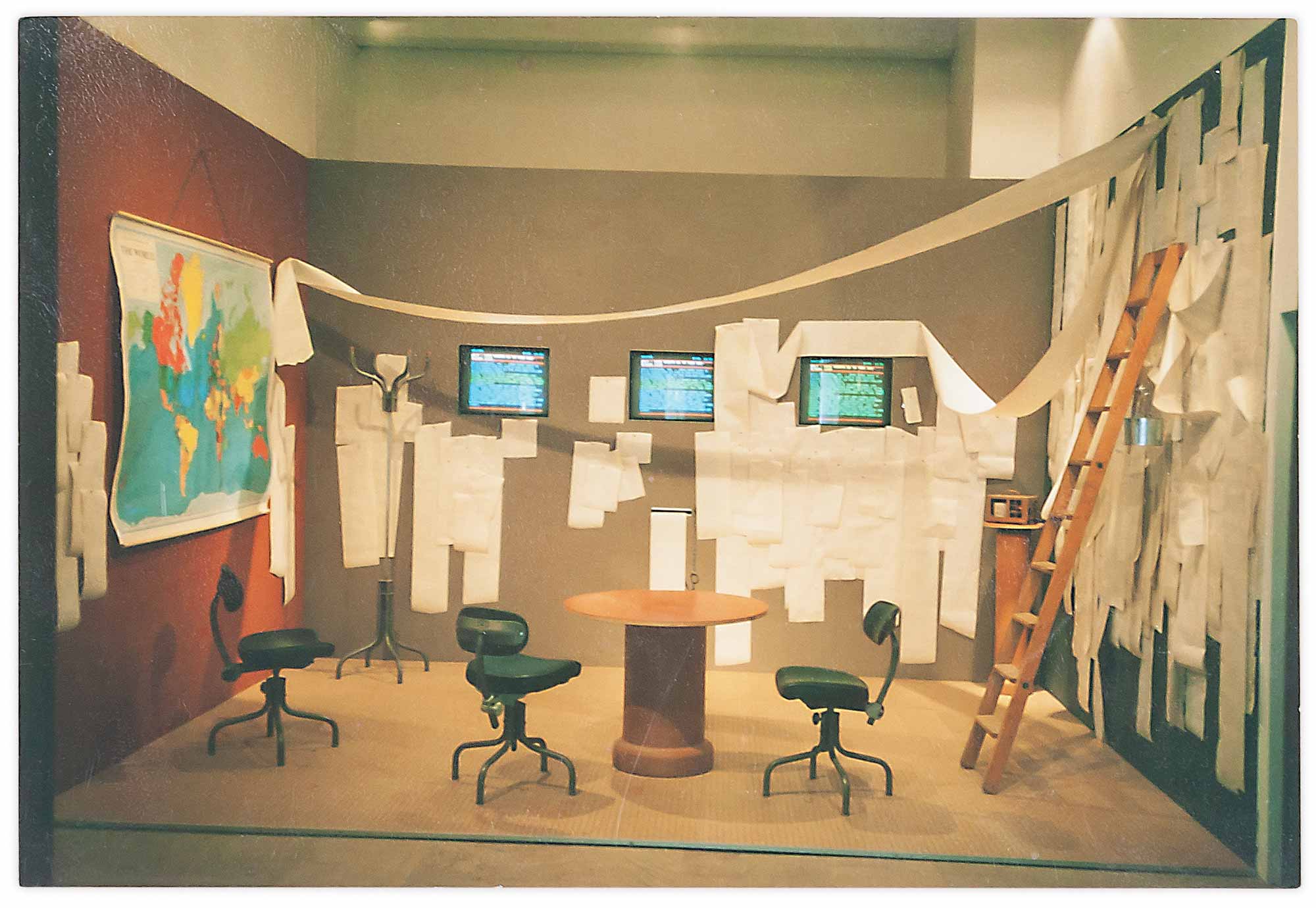
In 1988 Jasper told Rick Poynor: I wanted the design to be very obvious. In fact, there was as little design in there as possible. It’s all either ready-made or taken from somewhere else. At the end of the exhibition, the pieces in the News Centre were returned to Jasper. He kept the collage, the three office chairs and at least part of the Office System in his studio/bedroom at home in London, as seen here (final picture) in 1988. Later that year, the collage was shown in Vienna (see the main picture). Its whereabouts are now unknown. It is thought to have remained in Vienna after the exhibition.
